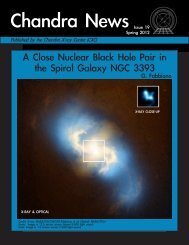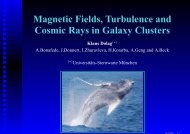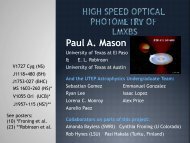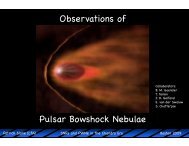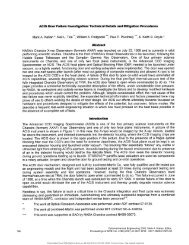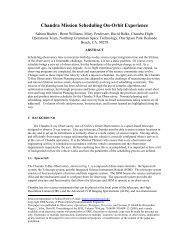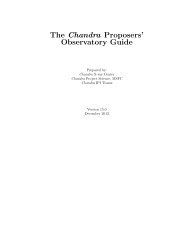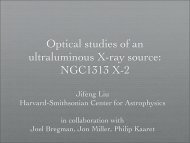observational overview of state transitions in x-ray binaries
observational overview of state transitions in x-ray binaries
observational overview of state transitions in x-ray binaries
You also want an ePaper? Increase the reach of your titles
YUMPU automatically turns print PDFs into web optimized ePapers that Google loves.
Power<br />
type-B frequency up<br />
1 10 100 1000<br />
Power<br />
2<br />
2 5 10 20 50 100<br />
Frequency (Hz)<br />
0.01 0.1 1 10 100 1000<br />
Frequency (Hz)<br />
s<strong>of</strong>t<br />
Power<br />
1 10 100 1000<br />
rms-drop<br />
0.01 0.1 1 10 100 1000<br />
Frequency (Hz)<br />
type-C frequency up<br />
Power<br />
1 10 100 1000<br />
0.01 0.1 1 10 100 1000<br />
Frequency (Hz)<br />
hard<br />
Power<br />
1 10 100 1000<br />
0.01 0.1 1 10 100 1000<br />
Frequency (Hz)<br />
Power<br />
1 10 100 1000<br />
0.01 0.1 1 10 100 1000<br />
Frequency (Hz)<br />
High Frequency QPOs<br />
Let’s take a look at what happens dur<strong>in</strong>g the <strong>transitions</strong> between the hard and s<strong>of</strong>t <strong>state</strong>.<br />
These <strong>transitions</strong> are host to various types <strong>of</strong> QPOs, with the two most common ones be<strong>in</strong>g<br />
named type-B and type-C QPOs - not very imag<strong>in</strong>ative. Let me start with the type-C. It<br />
usually sits on top <strong>of</strong> a strong noise component <strong>in</strong> a power spectrum. And it actually evolves<br />
from one <strong>of</strong> the broad noise components seen <strong>in</strong> the hard <strong>state</strong>. The evolution <strong>of</strong> the type-C<br />
power spectra is shown at the top. From hard to s<strong>of</strong>t, or right to left, the type-C QPO<br />
<strong>in</strong>creases <strong>in</strong> frequency by about a factor <strong>of</strong> a hundred, while it becomes weaker. Weak<br />
remnants <strong>of</strong> this QPO can be found <strong>in</strong> the s<strong>of</strong>t <strong>state</strong>, and we found that the maximum<br />
frequency observed scales <strong>in</strong>versely with the mass <strong>of</strong> the black hole <strong>in</strong> the few systems <strong>in</strong><br />
which it was found. The type-C QPOs can change from 0.01 to a few tens <strong>of</strong> Hz at vary<strong>in</strong>g<br />
lum<strong>in</strong>osity levels.<br />
It is still not clear what the changes mean, but if the QPO frequency is related to a radius, for<br />
example the <strong>in</strong>ner disk radius or the outer radius <strong>of</strong> the corona, this radius is gett<strong>in</strong>g smaller.<br />
Of course, as Phil mentioned earlier, it doesn’t have to be a radius, it could also be scale<br />
height <strong>of</strong> the disk for example.<br />
This smooth evolution <strong>in</strong> type-C QPOs is almost always briefly <strong>in</strong>terrupted by a short and<br />
sudden change <strong>in</strong> the variability properties. At a more or less fixed value <strong>of</strong> the spectral<br />
hardness, we see a drop <strong>in</strong> the overall strength <strong>of</strong> the variability. Just before that we actually<br />
see a change <strong>in</strong> the type <strong>of</strong> QPO from type-C to type-B. The broad peaked noise component<br />
disappears as well. The evolution <strong>of</strong> type-B QPO, which is shown on the left, is actually quite<br />
different - rather than a frequency dependence on hardness, we see a dependence <strong>of</strong><br />
frequency on lum<strong>in</strong>osity.<br />
The zone <strong>of</strong> strange power spectral properties also gives rise to the so-called high frequency<br />
QPOs, wich are typically observed at a few hundred Hz. They are observed as s<strong>in</strong>gle peaks, or<br />
as pairs. The s<strong>in</strong>gle peaks can move around by up to 15-20%, but the pairs are only observed<br />
at fixed frequencies, sometimes even years apart, suggest<strong>in</strong>g they are set by GR.




